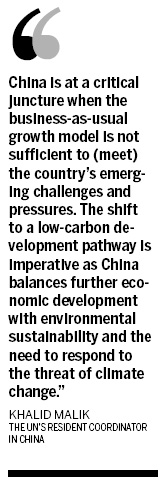Asia-Pacific
UN report urges move to low-carbon growth model
By Fu Jing (China Daily)
Updated: 2010-04-16 09:15
 |
Large Medium Small |
Beijing - China has "no other choice" but to shift to a low-carbon roadmap while charting its future social and economic development agenda, according to a report by the United Nations, released in the capital on Thursday.
China's current growth model is not sustainable in the medium to long term, the authors of the report have argued.

Prominent scholars, led by academics from the Renmin University of China, took nearly a year to prepare the report titled, 'Sustainable Future: Towards a Low Carbon Economy and Sustainable Society'.
"China is at a critical juncture when the business-as-usual growth model is not sufficient to (meet) the country's emerging challenges and pressures," said Khalid Malik, the UN's resident coordinator in China. "The shift to a low-carbon development pathway is imperative as China balances further economic development with environmental sustainability and the need to respond to the threat of climate change," he said.
The report has come out at a time when the nation is busy drafting its social and development agenda for the next five years; international climate change negotiations have been deepening, and southwest China, where the poverty rate is still relatively high, is reeling from a severe drought.
Meanwhile, China is also trying to step up efforts to cut carbon intensity to 40-45 percent from the 2005 levels by 2020.
Zou Ji, chief author of the report, said the low-carbon model might bring risks, including job losses, higher prices and fiscal revenue shortfalls. However, he said gains might accrue in the form of greater competitiveness in new technologies, a smooth alignment of technological innovation to help transition to the light industry and services' economy, an improved standing in the world, the extension of energy services, reduced harm to human health and the protection of vital ecosystems.
The report highlights that, if China can fully grasp the opportunities at hand, it will be possible to move to a society which is not only environmentally sustainable, but one that creates conditions for greater job creation, higher resource efficiency and energy security, enhanced food security, and better health for its people.
The report breaks new ground in linking economic growth, carbon emissions and human development in China. It offers policy options for a country that will see the migration of nearly 400 million rural Chinese into urban areas over the next two decades.
China has a unique opportunity to construct eco-cities on a major scale, says the report. "As a latecomer to development, China may be able to leapfrog over outdated technologies to embrace cleaner, greener options from the outset."
It will also need to "vigorously develop public mass transportation to prevent a massive increase in energy demand and carbon emissions from the transport sector.
The policy options in the report include gradual introduction of a low-rate carbon tax system in some select sectors to earmark the revenue to subsidize new technology research for adaptation of vulnerable groups to climate change.
Other recommendations include, strengthening coordination and integrating policies that deal with poverty alleviation, improvement of living standards through the provision and improvement of basic infrastructure, services and social security, reduction of greenhouse gases, and adapting to climate change.
And, to identify areas where investments in development can be maximized through the achievement of ancillary benefits in climate change and environment and creating conditions to prioritize these investments.
CHINA DAILY










